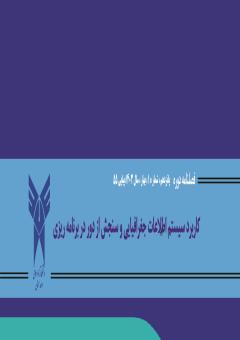مدلسازی ساختاری عناصر تببینکننده مخاطرات طبیعی در توسعه کلانشهر اهواز
محورهای موضوعی : کاربرد GIS&RS در برنامه ریزی شهری
مهناز عامری
1
![]() ,
محمدابراهیم عفیفی
2
*
,
مرضیه موغلی
3
,
محمدابراهیم عفیفی
2
*
,
مرضیه موغلی
3
![]()
1 - دانشجوی دکتری جغرافیا ، واحد لارستان ،دانشگاه آزاد اسلامی ،لار، ایران
2 - استادیار داشگاه آزاد اسلامی واحد لارستان
3 - دانشیار دانشگاه آزاد اسلامی لارستان
کلید واژه: توسعه, مخاطرات طبیعی, شهر اهواز, مدلسازی ساختاری تفسیری.,
چکیده مقاله :
در طول تاریخ حیات بشر مخاطرات طبیعی همواره وجود داشتهاند، اما بهواسطه رشد تصاعدی جمعیت و تراکم انسانها در تمام عرصههای زیستی بهخصوص در نواحی پرخطر، امروزه بشر شاهد بلایای بزرگی چون سیل، گردباد، خشکسالی و غیره میباشد. در همین راستا؛ هدف پژوهش حاضر شناسایی و تبیین ساختاری مؤلفههای تببینکننده مخاطرات طبیعی در توسعه کلانشهر اهواز است. از نظر هدفگذاری کاربردی و از نظر روششناسی به صورت توصیفی- تحلیلی است. جامعه آماری را اساتید دانشگاهی و خبرگان حوزه پژوهش در شهر اهواز تشکیل میدادند که به روش نمونهگیری هدفمند انتخاب شدند.از این رو در این پژوهش از نمونهگیری هدفمند قضاوتی(30نفر از اساتید دانشگاهها و متخصصین عرصه پژوهش) به منظور انجام و اجرایی شدن پژوهش انتخاب شدند. در جهت دستیابی به اهداف پژوهش با استفاده از متدولوژی تحلیلی نوین مدلسازی ساختاری تفسیری((ISM) روابط بین عوامل تعیین و به صورت یکپارچه تحلیل شد. در نهایت با استفاده از تحلیل MICMAC، عوامل با توجه به اثرگذاری و اثرپذیری بر سایر مولفه ها،تحلیل شدند. نتایج حاصل از مدل ساختاری تفسیری عوامل موثر بر توسعه درونی شهر نشان داد که مدل بدست آمده در بر گیرنده چهار سطح است و نتایج نشان داد که عوامل سیل و ریزگردها اساسیترین عوامل موثر بر توسعه درونی شهری است که باید در وهله اول بر آنها تاکید شود به عبارتی دیگر هرگونه اقدام برای زمینه سازی در جهت توسعه درونی شهر، مستلزم توجه به این عوامل در کنار سایر عوامل یاد شده است.
Throughout the history of human life, natural hazards have always existed, but due to the exponential growth of the population and the density of humans in all areas of life, especially in high-risk areas, today mankind is witnessing major disasters such as floods, tornadoes, droughts, etc. In this regard; The aim of the current research is to identify and explain the structural components explaining natural hazards in the development of Ahvaz metropolis. It is practical in terms of targeting and descriptive-analytical in terms of methodology. The statistical population consisted of university professors and experts in the field of research in Ahvaz city, who were selected by purposeful sampling. Therefore, in this research, 30 university professors and research experts were selected from the purposeful judgmental sampling in order to carry out and implement the research. became In order to achieve the goals of the research, using the new analytical methodology of Interpretive Structural Modeling (ISM), the relationships between factors were determined and analyzed in an integrated manner. Finally, by using MICMAC analysis, the factors with regard to their influence and effectiveness on other components, The results of the interpretative structural model of the factors affecting the internal development of the city showed that the obtained model includes four levels, and the results showed that the factors of flood and fine dust are the most basic factors affecting the internal development of the city, which should be considered in the first place. They should be emphasized, in other words, any action to lay the groundwork for the internal development of the city requires attention to these factors along with the other mentioned factors.
Bragagnolo, L., daSilva, R.V., Grzybowsk, J.M.V. (2020); Artificial neural network ensembles applied to the mapping of landslide susceptibility, CATENA, Vol 184, 10424: 1-19.
Christiaensen, L., De Weerdt, J., Kanbur, R (2015). Urbanization and Poverty Reduction: The Role of Secondary towns in Tanzania, Prepared for The Planning Commission, President’s Office, Tanzania.
Dodman, D., Leck, H., Rusca, M., & Colenbrander, S. (2017). African Urbanisation and Urbanism: Implications for risk accumulation and reduction. International Journal of Disaster Risk Reduction, 26(5): 7–15.
Hussain, M. A., Shuai, Z., Moawwez, M. A., Umar, T., Iqbal, M. R., Kamran, M., & Muneer, M. (2023). A Review of Spatial Variations of Multiple Natural Hazards and Risk Management Strategies in Pakistan. Water, 15(3), 407.
Kellogg CA, Griffin DW, Garrison VH, Peak HK, Royall N, Smith RM, Shinn EA, 2019. Characterization of aerosolized bacteria and fungi from desert dust events in Mali, West Africa. Aerobiologia, 20: 99- 110.
Laframboise, Nicole; Sebastian Acevedo (2020). “Man versus Mother Nature.” Finance & Development 51 (1): 44–47.
Ostrowska. M and Mazur. S. 2015. Risk in a Crisis Situation. Procedia Economics and Finance. No 3. Vol 23. Pp 1054-1059.
Rutgersson, A., Kjellström, E., Haapala, J., Stendel, M., Danilovich, I., Drews, M., ... & Wasmund, N. (2022). Natural hazards and extreme events in the Baltic Sea region. Earth System Dynamics, 13(1), 251-301.
Smith, Keith. Environmental hazards: assessing risk and reducing disaster. Routledge, 2013.
Su Jun -Pin., (2017), Analyzing policy impact potential for municipal solid waste management decision -making: A case study of Taiwan, Resources

